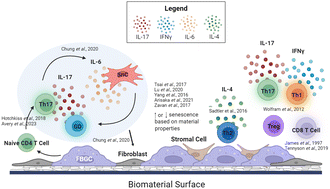The foreign body response: emerging cell types and considerations for targeted therapeutics
Abstract
The foreign body response (FBR) remains a clinical challenge in the field of biomaterials due to its ability to elicit a chronic and sustained immune response. Modulating the immune response to materials is a modern paradigm in tissue engineering to enhance repair while limiting fibrous encapsulation and implant isolation. Though the classical mediators of the FBR are well-characterized, recent studies highlight that our understanding of the cell types that shape the FBR may be incomplete. In this review, we discuss the emerging role of T cells, stromal-immune cell interactions, and senescent cells in the biomaterial response, particularly to synthetic materials. We emphasize future studies that will deepen the field's understanding of these cell types in the FBR, with the goal of identifying therapeutic targets that will improve implant integration. Finally, we briefly review several considerations that may influence our understanding of the FBR in humans, including rodent models, aging, gut microbiota, and sex differences. A better understanding of the heterogeneous host cell response during the FBR can enable the design and development of immunomodulatory materials that favor healing.

- This article is part of the themed collections: Biomaterials Science Recent HOT Articles and Biomaterials Science 10th Anniversary Collection


 Please wait while we load your content...
Please wait while we load your content...